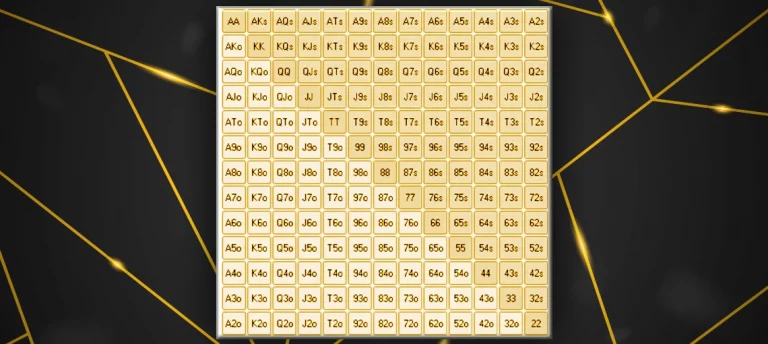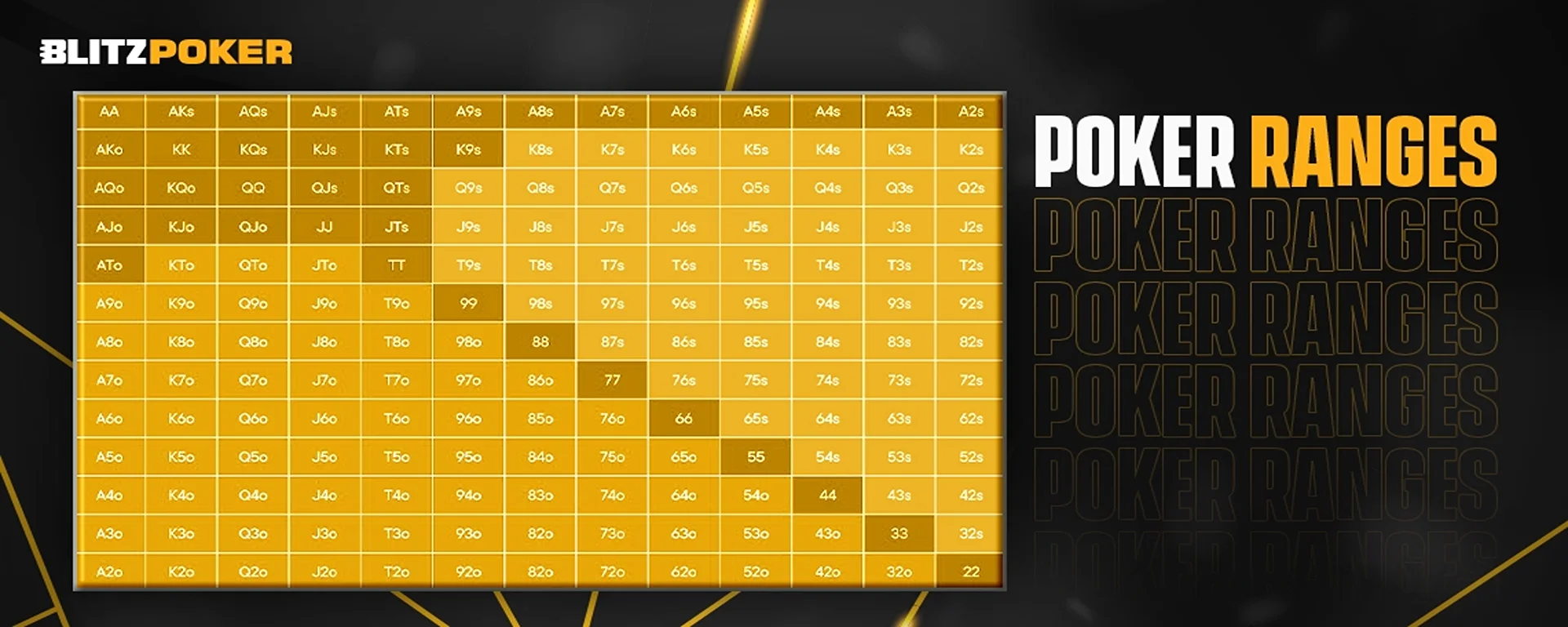Poker Ranges
To be able to identify as well as read ranges in poker is one of the most crucial skills to possess for a player. Poker revolves around the concept of incomplete information, leaving us in the dark about the specific pair of cards that our opponents have. However, by applying logical reasoning and leveraging our strong technical expertise, we can decipher the potential range of cards our opponents might have. Armed with this knowledge, we can then make calculated moves that maximize our profitability.
What are Poker Ranges?
A poker range refers to the complete set of possible hands that a player could have at any given moment. This range encompasses both the starting hands preflop and postflop. The composition of a player’s range can vary significantly, with conservative players having a narrower range, while more aggressive players have a wider array of starting hands. When analyzing the game, it is crucial to establish the potential range of your opponent’s hands before the flop. As the hand progresses and your opponent takes action, you continuously refine and adjust their range based on their behaviour and decisions.
Poker Range Chart
A visual representation of the poker ranges is known as what we call a poker range chart in poker. In Texas Hold’em, there exists a total of 169 possible hand combinations. These combinations can be neatly arranged on a 13×13 board, with suited hands positioned in the top right corner, offsuit hands placed in the bottom left corner, and pocket pairs spanning across the diagonal from the top left to the bottom right. When analyzing poker ranges, it can be helpful to visually identify each hand you believe your opponent might possess within their poker range.

In the matrix of poker hands provided above, it might appear that there is an equal distribution of each hand type. However, this is not the case. Among the available combinations, there are actually six pairs and 16 unpaired hands. Out of the unpaired hands, four of them are suited, while the remaining 12 are unsuited. Let’s consider the examples of KK and AQ for further illustration.
Paired Hands: We have a total of six paired hand combinations: K♥K♣, K♥K♦, K♥K♠, K♣K♦, K♣K♠, K♦K♠
Suited Hands: There are four suited hand combinations, with each suit represented: A♥Q♥, A♣Q♣, A♦Q♦, A♠Q♠
Unsuited Hands: There exist twelve unsuited hand combinations: A♥Q♣, A♥Q♦, A♥Q♠, A♣Q♦, A♣Q♠, A♦Q♠, A♣Q♥, A♦Q♥, A♠Q♥, A♦Q♣, A♠Q♣, A♠Q♦.
Using the Poker Ranges RIght
Now that we understand what a poker range is, let’s explore how we can utilize it during gameplay. The primary purpose of a poker range is to aid us in hand reading. Hand reading involves analyzing the betting actions of our opponents to determine the likely range of hands they possess. By estimating their starting ranges and comparing them with their betting patterns, we can identify the hands they are representing from our own range.
For instance, if our opponent 3-bets preflop and continues to bet on the flop, turn, and river on a board of A♦9♣6♠4♠2♦, they are likely representing strong hands such as AA, AK, AQ, and AJ for value, while also possibly bluffing with hands like KQ, QJ, or 87.
It is crucial to maintain consistency in our opponent’s range as the hand progresses. One common mistake is to suddenly assume that a player can have a specific hand in their range on the turn, even if we had already eliminated it on a previous street. Let’s consider an example:
Suppose your opponent raises from under the gun (UTG) at a nine-handed table, and you call from the big blind with 4♦5♦. Assuming your opponent is a skilled player, you assign them a range of 77+, AQo+, AJs+, and JTs+. The flop reveals 4♠5♠6♦. You check, your opponent bets, you raise, and then your opponent shoves.
At this point, your concern may be that your opponent has a straight with hands like 76 or A2, a better two-pair with 53 or 54, or a set with 33, 44, or 55. But you need not worry because those hands were not part of your opponent’s estimated preflop range, indicating they are unlikely to be in their post-flop range.
When utilizing poker ranges, it’s essential that you begin with the estimated preflop range of your opponent. As the hand progresses and your opponent’s actions provide you with more information, you can gradually eliminate more hands from their range, gaining a clearer understanding of the hands they are likely holding.
Calculating Poker Ranges
Calculating poker ranges can be a challenging task, as it requires accurately estimating the hands your opponents are likely to play. While we can’t read their minds and fully comprehend their thought processes, we can still utilize available information to create a close approximation of their playing range. Here are some factors to consider when constructing a range for your opponent:
Know Your Opponent
Take into account the characteristics of your opponent. Are they an older person with a newspaper and coffee or a young individual wearing a hoodie and sunglasses? While every one is equal at the poker table, factors such as appearance, age, and demeanour can provide insights into their playing style. A general guideline is that older players tend to play more tightly due to the stereotype that they are risk-averse.
Additionally, if it’s a live table, pay attention to what your opponent is wearing, as it can offer clues about their playing style. For instance, if they’re casually dressed in jeans and a hoodie, it suggests they might be a regular player who frequents the casino without dressing up. Conversely, if your opponent is dressed in a cocktail dress or business suit, they may be less experienced in a casino setting.
Regardless of their appearance, the crucial information to gather is whether the player tends to play looser or tighter compared to standard ranges.
Consider Preflop Position
Once you have assessed the type of opponent you’re facing, consider their position at the start of the hand. Are they under the gun (UTG), in the late position, or somewhere in between? A player’s position significantly influences their range composition, assuming they are competent. If they are raising from an early position, their range is likely to be tighter, whereas raising from a late position suggests a wider range.
It’s important to combine all available information to create an overall understanding of your opponent. Therefore, incorporate the inferences you’ve made about their playing style based on their appearance when determining their preflop range according to their position.
Observe Their Actions
Your opponent’s actions during the hand, both preflop and postflop, should influence the range you assign to them. Starting with preflop, did they raise or limp? Did they call a raise or three-bet? Different actions indicate different ranges for your opponent. For example, most players would three-bet with a hand like AA or KK instead of just calling a raise. Thus, you can exclude AA and KK from their range when considering your opponent’s holdings.
The same principle applies to postflop play. Your opponent’s actions shape the hands they are likely to have in their range. Consider a scenario where you raise from the button with A♥8♥, and your opponent calls from the big blind. The flop comes 8♣️6♠️2♥, and your opponent checks. You bet the size of the pot, and your opponent calls. Then a Qs appears on the turn.
Should you be concerned? Let’s analyze your opponent’s actions. While they may have called preflop with some hands containing a Q, they also called a pot-sized bet on an 8♣️6♠️2♥ flop. This simply suggests that their range more likely consists of pairs and straight draws, making the Qs a safe card for you, despite it being an overcard.
Leverage Past Information
Keep a close watch on your opponents to identify any unexpected actions that deviate from the profile you have constructed for them. If you initially believed a player to be tight, but then you witness a showdown where they raised from UTG with T5s, pay attention to that information. It indicates that your initial assumption may have been incorrect, and you should adjust your perception accordingly.
Many players make the mistake of assuming someone plays a certain way and fail to update their perception even when presented with contradicting information. Instead, continuously gather information during your time at the poker table and use it to enhance your understanding of your opponents’ tendencies.
While we cannot attain a perfect depiction of our opponent’s range, by considering these four points, you can develop a reasonable understanding of the hands they are likely to play.
What’s The Significance Of Poker Ranges?
Poker hand ranges are vital in the game because they provide a framework for analyzing and predicting your opponent’s possible hands based on the available information. Instead of trying to guess the exact cards your opponent holds, it is more effective to estimate the range of hands they could be playing.
Incorporating poker ranges into your game is a common practice among successful poker players. It allows you to make more informed decisions and develop strong hand-reading abilities, which are essential for consistent winning results.
Understanding and studying poker ranges early in your poker journey is crucial. It forms the foundation for improving your hand-reading skills and becoming a proficient player. By getting familiar with different ranges, you can gain valuable insights into your opponent’s likely holdings, enabling you to make better strategic choices.
Not just this, comprehending poker hand ranges empowers you to construct your own ranges in specific situations. This skill is crucial for adapting to different scenarios and optimizing your decision-making process as a poker player.
